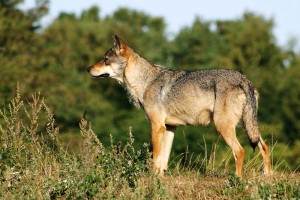 The gray wolf is an agile, enduring, observant and alert animal, adjusting quickly to changes in its environment. Being carnivorous, active any time of day, ability to proliferate intensively – all that enables the species to restore the population following occasional declines. In the late 19th century wolves were numerous. By 1940’s, their density declined to minimal. In the first postwar years, wolves were encountered in all districts of the region, in certain areas they were marked as multitudinous and dealing considerable damage to cattle-breeding and hunting. The measures adopted in 1945 to combat wolves – extermination of pups, killing, entrapment, use of poison baits etc. – led to a drastic drop of populations in the 1950’s. Starting mid 1970’s, the wolf livestock has been growing. In the 15 years of 1976-1990, procurement of wolf hides has been fluctuating from 127 to 321 a year.
The gray wolf is an agile, enduring, observant and alert animal, adjusting quickly to changes in its environment. Being carnivorous, active any time of day, ability to proliferate intensively – all that enables the species to restore the population following occasional declines. In the late 19th century wolves were numerous. By 1940’s, their density declined to minimal. In the first postwar years, wolves were encountered in all districts of the region, in certain areas they were marked as multitudinous and dealing considerable damage to cattle-breeding and hunting. The measures adopted in 1945 to combat wolves – extermination of pups, killing, entrapment, use of poison baits etc. – led to a drastic drop of populations in the 1950’s. Starting mid 1970’s, the wolf livestock has been growing. In the 15 years of 1976-1990, procurement of wolf hides has been fluctuating from 127 to 321 a year.
Mating wolves are sedentary. In the fall and winter, they migrate in search of food individually, in couples, or affined packs of 7-10. They hunt elks, roes, hares, birds and quite often domestic animals. In bio-communities, as well as in selection of the wild hoofed animals, the role of wolves is recognized as positive. However, the damage the species does to cattle-breeding and hunting fauna necessitates cuts of populaces to optima, retaining the gray wolf as a species.
/ * The photos at lake.peipsi.org are cross-posted from commons.wikimedia.org and are used for familiarization purposes only. No commercial use of the photos is allowed. For more information about to use the photos see the originals on commons.wikimedia.org. /


